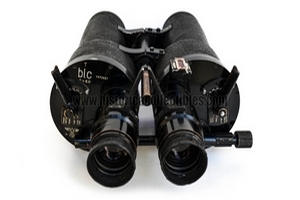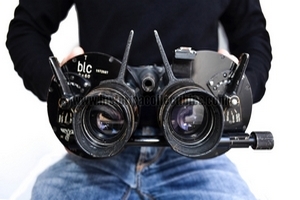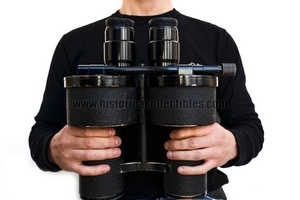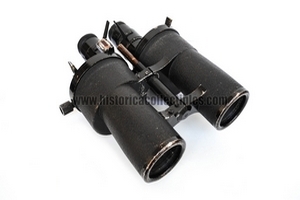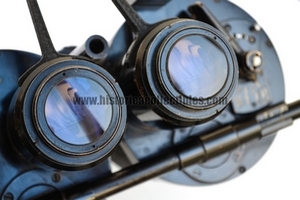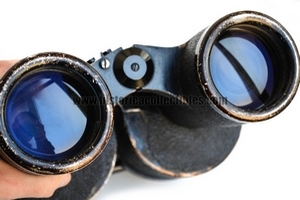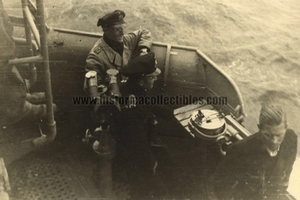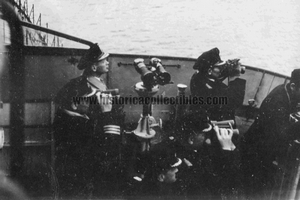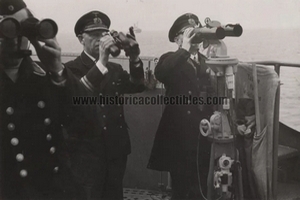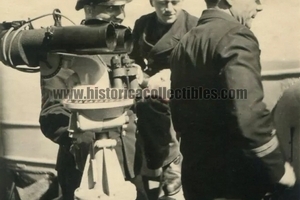Doppelfernrohr 8x60 "Deck Mounted" BLC (Carl Zeiss) Kriegsmarine, 1939
“DECK MOUNTED 8x60”, binoculars mounted on the platform (deck) of a German warship, produced in only 100 units, for the Kriegsmarine.
Made by “BLC” encrypted code name of Carl Zeiss Jena, with production number 1972587, which corresponds to having been built in December 1939 (at the disposal of the Oberkommando der Wehrmacht).
The binoculars are an 8x60 Porro II and were designed to be able to follow the search for aircraft at night. This naval model has the Reichsadler (Imperial Eagle) imprinted on the part of the left eyepiece with the initials "M IV/1" to indicate the production of Zeiss binoculars verified and accepted by the German Navy, while the letter "N" indicates Nordsee (or naval base located in the North Sea), the number "184" probably indicates the serial number of assignment to a specific ship.
The binoculars are equipped with four filters: Ohne Glas (glass-free), Klar (clear), Sonne (sun), Scheinwerfer (lighthouse). On both sides the filters are individually adjustable. The filters are in two colors: orange in the “Sonne” position and dark gray in the “Scheinwerfer” position.
The letter “T” on the left side, in German "Transparenzbelag", indicates that the lenses are coated with an anti-reflective treatment which improved the light transmission in the lenses by 80%. This system was developed and patented on November 1, 1935 by Aleksander Smakula, a member of the Zeiss staff in Jena since 1934. The lenses of the two eyepieces are large, with a diameter of 32 mm.
The interpupillary distance is easily adjusted on the binoculars by turning the bar located under the eyepieces. The focus is easily adjusted on both eyepieces by rotating the lever located on them. The original eyecups are mounted on the eyepieces: metal ring with rubberized cloth on the upper part. Inside the right eyepiece there is a graticule in the shape of a vertical line with a small horizontal line in the center, which forms a +.
On the top of the right eyepiece tube there is the connection for the lamp that illuminates the reticle. A small chip, present in the right prism, absolutely does not affect the view which is clear and sharp. The view is perfectly collimated and truly incredible. Its overall weight is approximately 4.5 kg. This model is certainly among the most interesting binoculars produced for the Kriegsmarine and its rarity makes it one of the most coveted and requested pieces by collectors of optics, used throughout the Second World War.
Carl Zeiss takes its name from its founder, Carl Zeiss, who on November 17, 1846 chose the small city of Jena, in Thuringia, as the location for his precision optical equipment factory. Thanks to the strict quality control that Carl Zeiss imposed on its products, going so far as to personally destroy the microscopes that did not pass the tests, the newborn Zeiss became the official supplier of the University of Jena and received the gold medal of the industrial exhibition in 1861 of Thuringia as the best research instrument produced in Germany, awarded to the Stand I microscope of 1857.
In 1866 the thousandth microscope was produced and the name Zeiss became known throughout European scientific circles. Thanks to studies on the Porro prism, in 1893 Abbe patented double prism binoculars, which accentuated the perception of depth.
The mass production of Zeiss binoculars began in 1894, already at the beginning of the twentieth century more than 30,000 were made, by the beginning of the First World War the figure had risen to 500,000 and, by the end of the Second World War, 2,260,000 were produced binoculars for the civil and military market.
Thanks to studies conducted on the perception of light in low light situations, it was shown that the average dilation of the pupil in an adult is about 7 mm. For this reason, the 7x50 mm model was introduced in 1910 and remained on the market until 1917 with few changes to the materials used. In 1926, following the post-war crisis of the First World War with the Treaty of Versailles which bankrupted many important German companies, Zeiss bought the "C.P. GOERZ" and founded the Zeiss Ikon in 1926.
In 1937 Zeiss had commercial contacts and factories in more than 29 countries around the world. From '33 Zeiss acquired interest from the Nazi regime, which balanced production towards military instruments. It successfully produced binoculars with wide-angle optics for military use, pressure resistant optical systems for U-boats, periscope binoculars for targeting tanks. Furthermore, Zeiss cameras were mounted on the V2s for remote sensing operations of the English coasts.
On November 1, 1935, Zeiss, in the person of Alexander Smakula, patented a process for the treatment of optical glasses with extraordinary results in terms of light transmission. Remained a military secret until 1939, it was adopted on binoculars to reduce ghost images and internal reflections. During the Second World War, there were numerous bombings against the Zeiss factories. Jena was bombed several times by the Allies starting in 1944. Stuttgart was razed to the ground, although the Contessa-Nettel factory suffered little damage. The bombing of Dresden, in addition to devastating the city, also caused considerable damage to the Zeiss Ikon headquarters.
On April 13, 1945, American military forces entered Jena, surprising themselves that the bombing had not caused any significant damage. The main planetarium was in ruins, while the factories remained operational.

